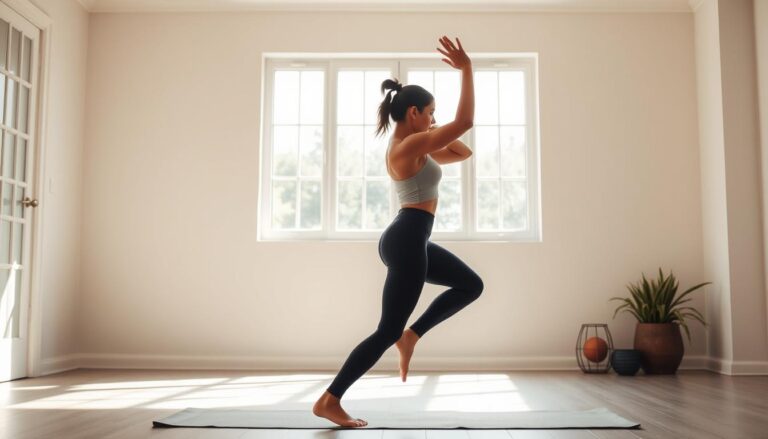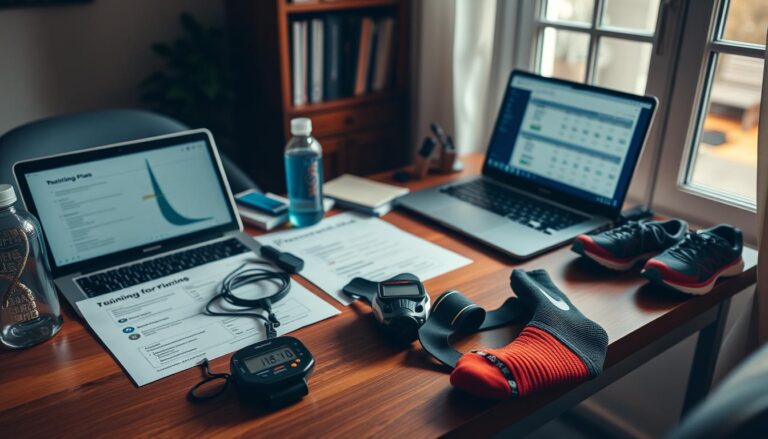
Imagine your child laughing as they chase a balloon. Their arms stretch up to the sky. This moment is not just fun. It’s building their health.
But with screens and busy lives, it’s hard to meet the 60 minutes of exercise kids need. The American Heart Association says this time is key. How do you make it happen? This article will show you how to turn play into progress.
Active play is more than just burning energy. It’s a way to build strong muscles, improve focus, and create lifelong habits. Picture your child feeling proud after mastering a cartwheel or working together in a game of tag. These moments are important.
Let’s look at how simple activities like “Row, Row, Row Your Boat” or trampoline time can change their development.
Key Takeaways
- Children need 60 minutes of daily physical activities for optimal health.
- Active play boosts strength, coordination, and social skills through games like “Hit the Balloon.”
- Safe environments and creative ideas make exercise feel like fun, not a chore.
- Family involvement and praise boost kids’ confidence in staying active.
- Indoor and outdoor options ensure activity is accessible year-round.
Why Physical Activities Are Essential for Your Child’s Development
activity is key for your child’s growth. It makes muscles strong, improves mood, and helps make friends. It also sets the stage for a healthy life.
Physical Benefits of Regular Exercise for Growing Bodies
Active play makes bones and muscles strong. It lowers risks of obesity and diabetes. Experts say kids need 60 minutes a day to stay healthy.
- Builds bone density and muscle strength
- Improve cardiovascular health and balance
- Lower risk of chronic diseases like type 2 diabetes
- Help maintain a healthy weight
Mental and Emotional Advantages of Staying Active
Movement is good for the brain too. It releases happy chemicals that reduce stress. Kids who exercise do better in school and feel more confident.
- Enhance focus and concentration
- Reduce anxiety and depression
- Boost self-esteem and emotional resilience
Social Skills Developed Through Group Activities
Team sports teach kids to work together and understand others. They learn to communicate, share, and lead. These skills help make lasting friendships and teamwork.
- Encourage teamwork and communication
- Teach leadership and conflict resolution
- Build empathy through shared goals
| Category | Benefits | Examples |
|---|---|---|
| Physical | Strong bones, weight management | Swimming, gymnastics, hiking |
| Mental | Focus, reduced stress | Yoga, dance, team sports |
| Social | Teamwork, communication | Soccer, relay races, tag games |
Every minute of play is an investment in your child’s future. Start today—explore activities they love and watch them thrive.
Age-Appropriate Physical Activities for Kids
Choosing age-appropriate physical activities keeps kids engaged and safe. Let’s look at activities for each age:
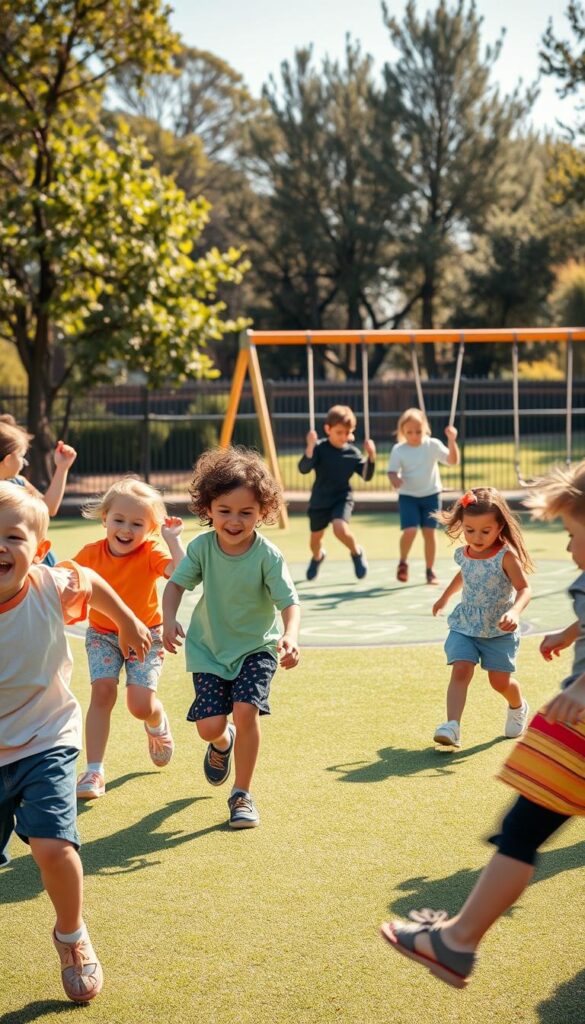
Children aged 3–5 need active play all day. Kids 6–17 should do 60 minutes of exercise daily. This includes activities that strengthen muscles and bones, 3 times a week (CDC).
Toddler activities (2–4 years): Focus on exploration. Encourage jumping jacks, balance beam practice, or “keep the balloon up” games. Unstructured play like dancing or chasing bubbles boosts coordination without rules.
Elementary school exercise (5–8 years): Start with simple games like Simon Says, scavenger hunts, or hopscotch. These games help with teamwork and motor skills. Try park running or hula hooping for fun.
Preteens (9–12 years): Move to organized sports like soccer, swimming, or lacrosse. Add pull-ups, wall sits, or yoga for strength. Activities like bocce ball or twister add strategy and balance challenges.
Teen fitness (13–17 years): Focus on social and skill-based activities. Group sports, hiking, or skateboarding keep them engaged. Include weight training under supervision if part of school teams.
| Age Group | Key Activities |
|---|---|
| 2–4 | Free play, obstacle courses, dancing |
| 5–8 | Simon Says, scavenger hunts, tag |
| 9–12 | Soccer, swimming, yoga |
| 13–17 | Lacrosse, weight training, rock climbing |
Match activities to your child’s interests. Let them explore while meeting daily movement goals. Adjust based on their energy and preferences!
Fun Outdoor Physical Activities for Kids
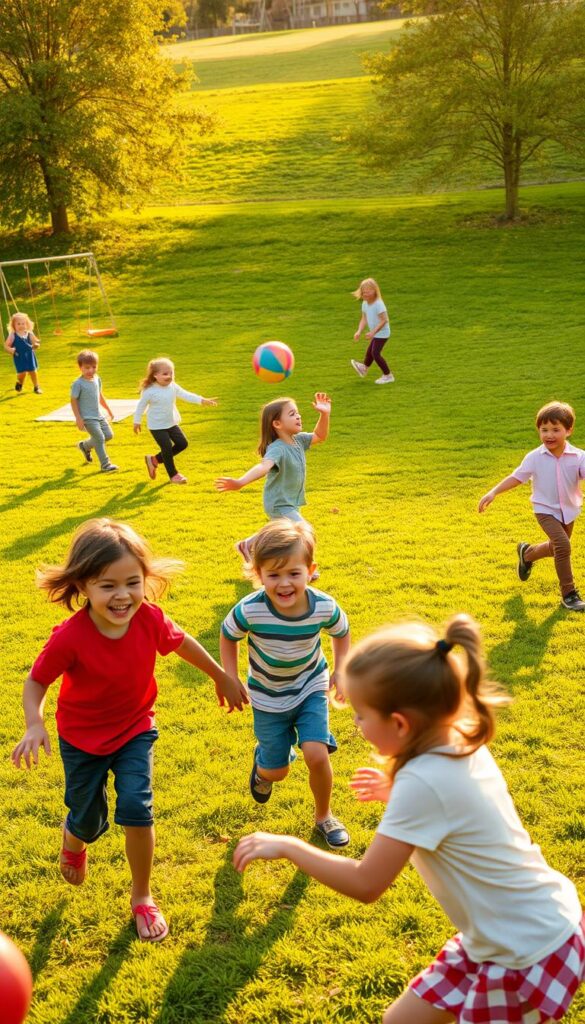
Outdoor games for kids do more than just burn energy. They spark curiosity and build skills. Let’s look at how to make playtime exciting and educational. From playground games to nature adventures, each activity helps kids grow and have fun.
Playground Games and Adventures
Make playground visits exciting with creative twists. Try tag races or hopscotch drawn with chalk. Activities like swing competitions or monkey bar races improve coordination.
Scavenger hunts can count birds or balance beam times. These games add fun to the usual playground visit.
Sports and Organized Team Activities
Kids sports are more than leagues. Backyard soccer or basketball teach teamwork. Try water balloon volleyball or chalk-drawn obstacle courses for fun.
Organized sports like flag football or baseball clinics are fun. Even simple games like bucket and sponge relays can be mini-Olympics.
Nature Play for Children
Nature play connects movement with discovery. Hikes can be treasure hunts for leaves or animal tracks. Try geocaching with a family GPS or create obstacle courses with sticks and stones.
Backyard gardening teaches digging, weeding, and patience. It keeps kids active while learning.
| Activity | Skills Developed |
|---|---|
| Tag | Speed, reaction time |
| Swimming | Cardio, coordination |
| Geocaching | Navigation, problem-solving |
| Swing games | Core strength, balance |
Every outdoor moment builds confidence. Mix games with exploration for a fun season.
Engaging Indoor Physical Activities for Rainy Days
When it rains, don’t let kids get bored. Rainy days are great for indoor activities for children that keep them active. These rainy day physical activities turn homes into fun zones with simple items. Let’s explore fun ways to keep kids moving without leaving the house.
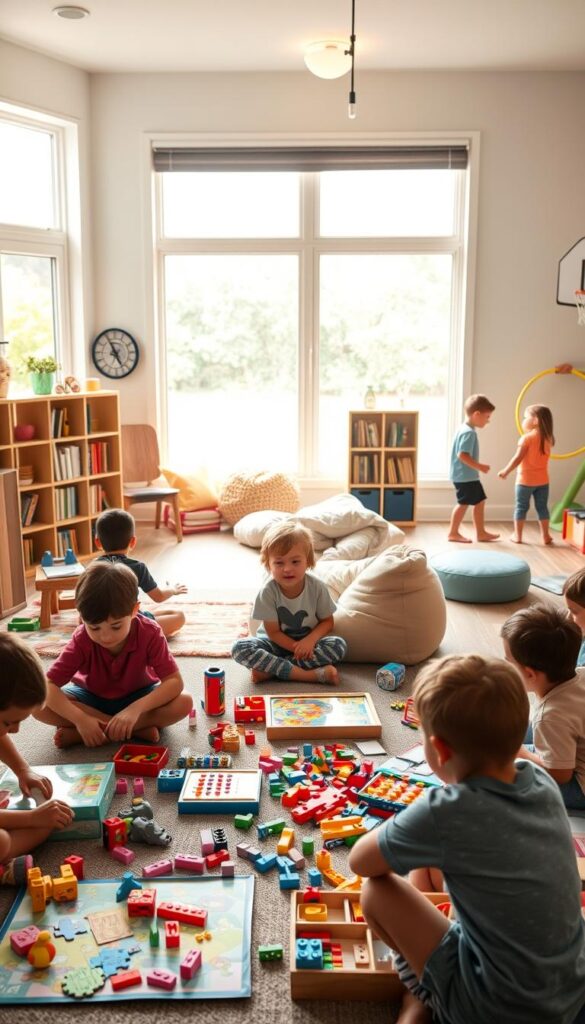
Home Obstacle Courses and Fitness Challenges
Make furniture into fun zones. Couch cushions can be hurdles and masking tape lines can be balance beams. Here are some ideas:
| Activity | Description | Materials |
|---|---|---|
| Puddle Jumping | Jump over paper puddles laid on the floor. | Newspaper, colored paper |
| Box Crawling | Crawl through large cardboard boxes. | Cardboard boxes |
| Indoor Obstacle Course | Use chairs and tape to create paths. | Chairs, masking tape |
Dance and Movement Games
Play music and let them dance! Games like freeze dance or GoNoodle videos keep energy up. Here are some ideas:
- Act out animal movements: “Gallop like a horse!” or “Waddle like a penguin!”
- Freeze dance: Stop when the music pauses.
- Action stories: “Walk across a pretend lava floor (marked by tape)!”
Indoor Sports Adaptations
Make indoor versions of outdoor games. Use soft balls and tape lines for safety. Try:
- Bowling with water bottles and a soft ball.
- Sock basketball with laundry baskets as hoops.
- Tape soccer goals on the floor with a beanbag ball.
Pair home fitness for kids with clear rules to avoid accidents. Mix structured games with free play for fun. These indoor games show even small spaces can be big adventure zones.
Physical Activities for Kids That Build Strength and Coordination
Building strength and coordination starts with fun strength building exercises for kids. Try crab walks or balancing on one foot. These activities strengthen muscles and improve spatial awareness. Do these activities at least three times a week to see progress in muscle development and agility.

- Obstacle Courses: Create a course with crawling, jumping, and balancing challenges using household items.
- Bear Crawls: Have kids move on hands and feet. This engages core muscles and improves coordination.
- Freeze Dance: Stop the music suddenly. This helps kids practice quick stops and sharpens reaction times.
- Balloon Volleyball: Keep a balloon up using hands or feet. This game builds hand-eye coordination.
Bijou Build offers modular setups for safe, adaptable coordination activities for children. Choose games that mix movement types, like hopping, leaping, and tossing. This engages multiple muscle groups. Make sure kids have fun; when they enjoy it, they’ll naturally try harder. Remember, consistent practice, not pressure, leads to lasting muscle development.
Low-Cost and No-Equipment Physical Activities Your Family Can Enjoy Together
Family fitness doesn’t have to be expensive or need special gear. Backyard races and living room dance-offs are fun. They make any space an adventure. These budget-friendly activities help everyone stay fit and bond without spending money.

Body Weight Exercises for Kids
Make workouts fun with no-equipment exercises like jumping jacks and yoga. Turn squats into “monster walks” or a “push-up pyramid” where everyone adds reps. Use a star chart to track progress and stay motivated.
Traditional Games That Keep Kids Moving
- Play Ninja Game—a tag-style chase where “ninjas” sneak past guards.
- Rediscover classics like Ghosts or This or That.
- Host a “Simon Says Olympics” with creative commands like “Simon says hop like a frog!”
Family Challenges That Promote Healthy Competition
Set up scavenger hunts in your backyard or living room. Challenge everyone to a “30-second dance battle” during TV breaks. Turn chores into races, like who can pick up toys fastest. Track weekly wins on a fridge chart for friendly rivalry.
“The best workouts are the ones that feel like play,” says Storytellinging Activities. “Laughter burns calories too!”
From “statue freezes” to relay races using couch cushions, creativity is your only limit. These family fitness activities show that movement and memories are best together.
Seasonal Physical Activities to Keep Kids Active Year-Round
Changing play with the seasons keeps kids happy and healthy. Seasonal activities for kids make weather an adventure, not a problem. Here’s how to adapt:
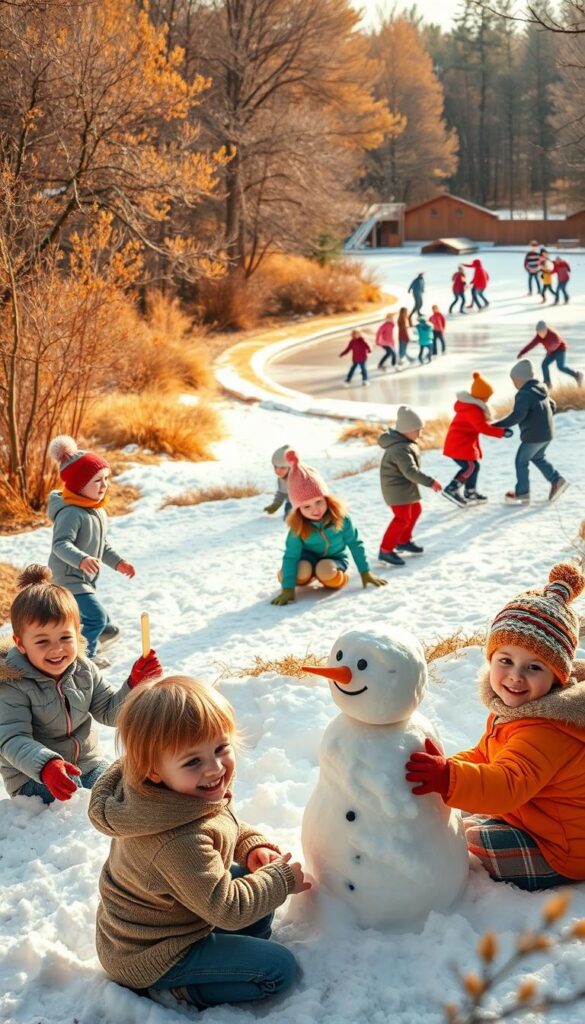
| Season | Activities | Tips |
|---|---|---|
| Winter | Sledding, snowball target practice, indoor dance parties | Layer clothing and stay hydrated during winter exercise for children. |
| Summer | Swimming, summer games like water balloon relays, sidewalk chalk obstacle courses | Play in cooler morning/late afternoon hours. Use shaded areas. |
| Fall | Leaf jumping contests, pumpkin relay races, nature scavenger hunts | Wear sturdy shoes for uneven terrain. Plan shorter outdoor sessions as temperatures drop. |
| Spring | Gardening (digging, carrying plants), puddle-jumping, kite flying | Layer clothing for unpredictable weather. Check for pollen allergies during outdoor play. |
Mix year-round fitness with fun family activities. Try Wii sports on rainy days or join community swim classes. Make daily walks into seasonal hunts—like “find red leaves” in fall or “spot winter birds.”
Always think about safety: use sunscreen in summer, check snow for sledding, and clear indoor spaces for obstacle courses. Small changes make activities fun all year!
How to Motivate Reluctant Kids to Participate in Physical Activities
Getting motivating inactive children to move needs creativity and understanding. Many kids don’t like exercise because it’s boring or stressful. By knowing what they like, you can make them excited about moving.
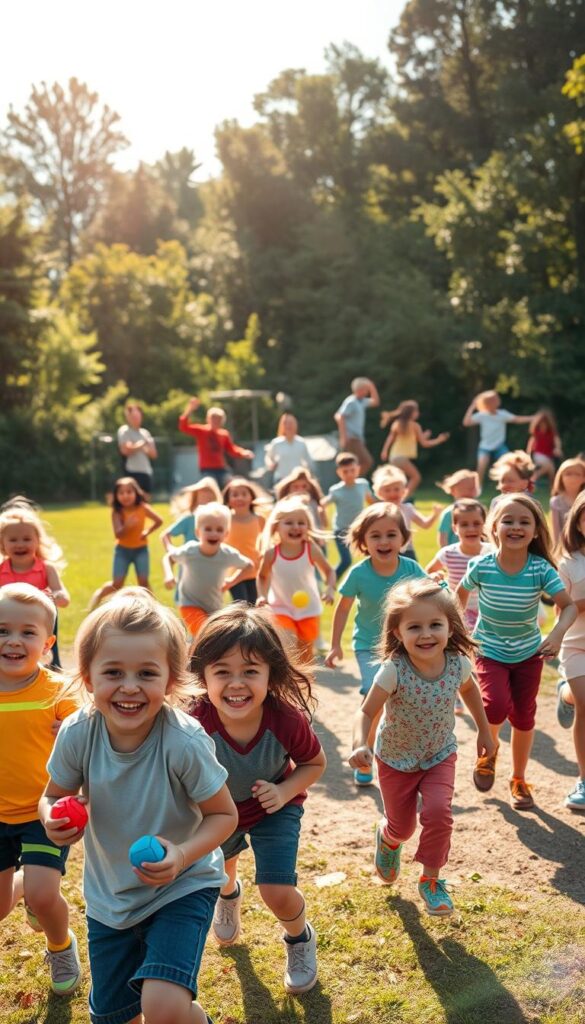
Making Exercise Fun Through Gamification
Make daily tasks fun with exercise for reluctant kids. Try these ideas:
- Treasure hunts: Hide objects around the yard and set movement challenges to find them.
- Step-counting apps: Use apps like Zombies, Run! that turn fitness into interactive games.
- Obstacle courses: Set up a backyard maze using pillows or cones for a backyard obstacle race.
Finding Activities That Match Your Child’s Interests
Link engaging sedentary children to hobbies they already love. For example:
- Art lovers: Paint with giant chalk outdoors or dance to music while drawing.
- Screen fans: Swap sedentary gaming for active options like Just Dance or Wii Sports.
- Story enthusiasts: Act out scenes from favorite books using imaginative play.
Creating Positive Associations with Physical Activity
Focus on joy over pressure. Avoid forcing activities or comparing kids to siblings. Instead:
- Praise effort: Celebrate small wins like “You tried harder today!”
- Choose group activities: Family walks or backyard soccer builds shared joy.
- Address fears: Talk openly about worries, like social anxiety, and adapt activities to ease stress.
Remember, consistency and patience matter most. Small, playful steps today can build lifelong habits.
Balancing Screen Time with Physical Activities for Modern Kids
Finding the right screen time balance is crucial for healthy kids in today’s world. Use tools like Qustodio or Screen Time
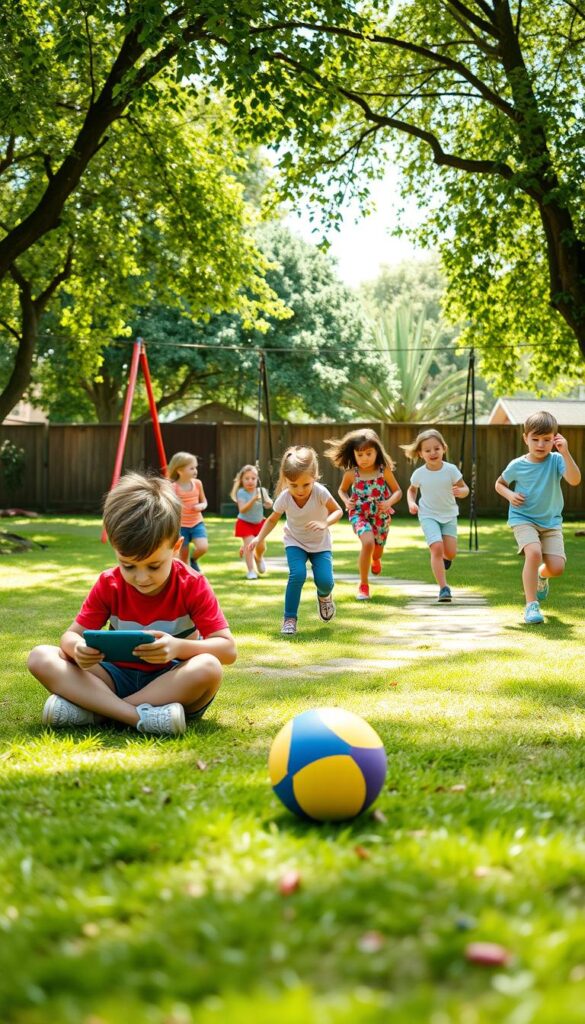
Make tech work for you with active screen alternatives like dance games or fitness apps. The Fitbit Ace 2 can encourage kids to move by tracking steps and setting goals. Try quick exercises like jumping jacks during commercials or yoga poses between shows.
| Strategy | Action |
|---|---|
| Create screen-free zones | Keep bedrooms and play areas tech-free to prioritize physical play. |
| Plan digital detox days | Weekly tech-free weekends boost creativity through outdoor hikes or board games. |
| Use tech to plan activities | Search local parks online, then visit them as a family. |
Use apps like Kids Yoga Adventure or Just Dance Kids to mix technology and exercise. Encourage kids to film themselves practicing new skills. This way, they learn while moving.
Teach kids about digital detox for kids by replacing screen time with hands-on activities. Build blanket forts, create DIY obstacle courses, or act out stories with figurines. Small steps can make a big difference—try 1 hour of screen time followed by 30 minutes of play.
Safety Tips for Different Types of Physical Activities
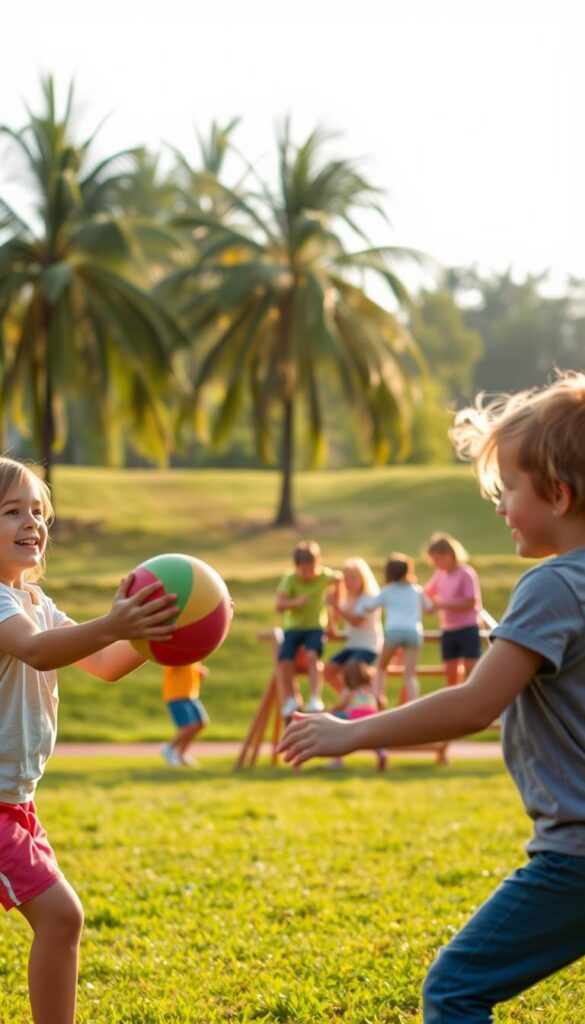
Keeping kids safe in sports starts with getting ready. Make sure child exercise precautions like helmets fit right. Check for broken gear and safe play areas.
Always give water and sunscreen when playing outside.
- Use helmets for biking, skating, or contact sports
- Ensure shoes match the activity (e.g., cleats for soccer, non-slip socks for gymnastics)
- Clear play zones of tripping hazards like loose cords or debris
Every kid is different. Look for signs they’re overdoing it: pain, tiredness, or not wanting to move. Teach them to stop if dizzy or out of breath.
Adjust activities if they show signs of preventing activity injuries, like limping or avoiding moves.
Don’t be afraid to ask for help. A doctor can check if they’re ready for sports. Coaches should know about health issues. If your child has trouble moving or keeps getting hurt, talk to a physical therapist.
Safety means making smart choices, not stopping play. Encourage rest days and learning new skills slowly. A safe and prepared child enjoys sports and stays fit for life.
Conclusion: Nurturing a Lifelong Love of Movement Through Physical Activities
Building lifelong fitness habits starts with making physical activity enjoyable. Only 24% of U.S. children meet daily exercise guidelines. It’s time to make a change.
Every jump, run, and play session helps kids grow a love for health. This love stays with them into adulthood.
Choose activities that spark your child’s curiosity. Whether it’s backyard tag, dance parties, or park adventures, movement appreciation begins when kids connect joy to motion. Research shows kids active in sports at 10 are twice as likely to stay active at 42. This shows early positive experiences shape lifelong choices.
Be a partner in exploration. Families that hike, bike, or play together create lasting bonds while modeling active living. Let your child try different sports, games, and outdoor explorations to discover what excites them. Celebrate small wins like mastering a cartwheel or finishing a family walk to build confidence.
Consistency matters more than perfection. Start with 10 minutes of daily movement—dancing to a favorite song, a backyard obstacle course, or a walk to the park. Small steps today lay the foundation for a lifetime of physical literacy and well-being. Remember, active parents raise active kids. Let’s turn off screens and turn on curiosity. The path to lifelong health begins with one playful step today.
FAQ
What are some effective physical activities for toddlers?
Toddlers aged 2-4 should play freely. Running, jumping, and balancing are good. Try simple games like tag or obstacle courses with household items.
How can I encourage my child to stay active if they prefer video games?
Mix physical activity with their favorite games. Use active video games or set movement breaks. Plan family game nights with physical challenges for fun.
What are some family-friendly exercises that require no special equipment?
Try bodyweight exercises like squats and planks. Play games like Red Light/Green Light or tag for fun movement without gear.
How often should children participate in strength-building activities?
Kids should do strength-building activities 3 days a week. Use bodyweight exercises and playful challenges that fit their age.
What outdoor activities can kids do during the summer?
Summer is great for swimming and playing in sprinklers. Try water balloon toss games. Outdoor sports and hiking are also good with the warm weather.
How do I keep kids active during bad weather?
Make indoor obstacle courses with pillows and chairs. Dance games with videos are fun too. Use soft balls for indoor games.
Why is it important for kids to participate in group physical activities?
Group activities teach kids to work together and communicate. They help build friendships and a sense of belonging.
What strategies can help motivate reluctant kids to be active?
Make activities fun with points and rewards. Find activities they enjoy. Make sure they see movement as fun, not a chore.
How can we safely introduce new physical activities to our child?
Know your child’s abilities first. Start with activities they’re comfortable with. Use proper equipment and safety measures. Ask experts for advice if needed.
What types of physical activities are beneficial for kids’ mental health?
Exercise helps reduce stress and improves mood in kids. It boosts focus and self-esteem. This is thanks to endorphins from exercise.










